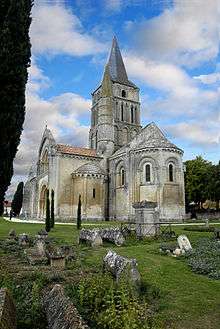Aulnay, Charente-Maritime
Aulnay, commonly referred to as Aulnay-de-Saintonge (French pronunciation: [onɛ.də.sɛ̃tɔ̃ʒ]), is a commune in the Charente-Maritime department in the Nouvelle-Aquitaine region of south-western France.
Aulnay | |
|---|---|
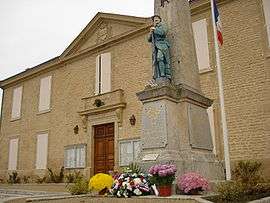 Town hall and war memorial | |
 Coat of arms | |
Location of Aulnay 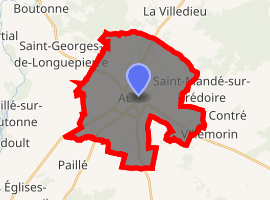
| |
 Aulnay  Aulnay | |
| Coordinates: 46°01′18″N 0°20′44″W | |
| Country | France |
| Region | Nouvelle-Aquitaine |
| Department | Charente-Maritime |
| Arrondissement | Saint-Jean-d'Angély |
| Canton | Matha |
| Intercommunality | CC Vals Saintonge |
| Government | |
| • Mayor (2014-2020) | Charles Bellaud |
| Area 1 | 30.97 km2 (11.96 sq mi) |
| Population (2017-01-01)[1] | 1,369 |
| • Density | 44/km2 (110/sq mi) |
| Time zone | UTC+01:00 (CET) |
| • Summer (DST) | UTC+02:00 (CEST) |
| INSEE/Postal code | 17024 /17470 |
| Elevation | 32–107 m (105–351 ft) (avg. 54 m or 177 ft) |
| 1 French Land Register data, which excludes lakes, ponds, glaciers > 1 km2 (0.386 sq mi or 247 acres) and river estuaries. | |
The inhabitants of the commune are known as Aulnaysiens or Aulnaysiennes.[2]
Geography
Aulnay is located on the Via Turonensis. one of the Ways of St. James some 45 km east by south-east of Surgères and 17 km north-east of Saint-Jean-d'Angély. Access to the commune is by the D950 from Les Églises-d'Argenteuil in the south-west which passes through the commune just west of the town and continues to La Villedieu in the north. The D121 comes from Saint-Georges-de-Longuepierre in the north-west passing through the town and continuing south to Cherbonnières. The D129 comes from Varaize in the south passing through the town and continuing north-east to Saint-Mandé-sur-Brédoire. The D133 goes from the town south-east to Néré. In the commune there is the village of La Cressoniere west of the town, Pinsenelle north-west of the town, and Salles-lès-Aulnay east of the town. Apart from the urban area of the town the commune is entirely farmland.[3]
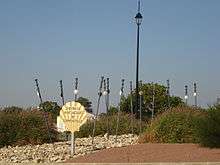
Hydrography
The Brédoire river flows through the commune and the town from east to west to join the Boutonne at Nuaillé-sur-Boutonne. Although a small river the Brédoire flooded the town in December 1982. The Palud flows through the north of the commune from the east to join the Brédoire at La Cressoniere. The Saudrenne flows from the east in the south of the commune forming part of the southern border before continuing to join the Boutonne at Saint-Pardoult.[3]
Neighbouring communes and villages[3]
History
Aulnay during the Roman Empire
Formerly called Aunedonnacum in the itinerary of Antoninus Pius and Auedonnaco in the Tabula Peutingeriana, Aulnay was a Gallo-Roman station on the important imperial Roman road between Saintes and Poitiers, and possibly between Saintes and Lyon before a more direct route, the Via Agrippa, was built.
Aerial photographs taken by aerial archaeologist Jacques Dassié and archaeological excavations have revealed a remarkable Roman camp at a place called Rocherou. This castrum was created for strategic reasons around the year 21 AD and abandoned around the year 43 AD. Its construction was carried out modelled on Roman camps in the conquest of Germania under the Principate of Augustus (along the Lippe) and also on camps on the limes of the Rhine due to the attested presence of displaced legions from Germania. Several Roman inscriptions have been found.
Aerial photography has also revealed the existence of a Fanum with a polygonal Cella and a Peribolos, proof of the existence of an important Gallo-Roman city.
Aulnay in the Middle Ages
As the capital of a fiscal jurisdiction Aulnay was already the seat of a lordship in 925, as evidenced by the donation made by Cadelon I to several abbeys. The Viscounts of Aulnay (or Viscounts of Aunay) were descendants of other noble families in Poitou and Saintonge and lived in a castle which was demolished in 1818 but whose tower still remains.[4][5]
Aulnay in the contemporary era
A common name for Aulnay is Aulnay-de-Saintonge but under the Ancien Régime Aulnay (often spelled Aunay) did not belong to the province of Saintonge but to the Province of Poitou and the Diocese of Poitiers.
By decree dated 12 December 1973 the commune of Salles-lès-Aulnay merged with the commune of Aulnay.
Aulnay is the capital of the canton of Aulnay-de-Saintonge which has the largest extent in the department of Charente-Maritime.
Heraldry
 Arms of Aulnay |
Blazon: Or, a pale the same between four lozenges of Gules posed in pale..[6] |
Administration
List of Successive Mayors[7]
| From | To | Name | Party | Position |
|---|---|---|---|---|
| 1920 | 1929 | Roger Chapeaud | ||
| 1933 | 1967 | Roger Chapeaud | ||
| 1967 | 1989 | Pierre Chapeaud | ||
| 1989 | 2001 | Bernadette Guillard | ||
| 2001 | 2014 | Jean-Mary Collin | ||
| 2014 | 2020 | Charles Bellaud |
(Not all data is known)
Demography
In 2010 the commune had 1,464 inhabitants. The evolution of the number of inhabitants is known from the population censuses conducted in the commune since 1793. From the 21st century, a census of communes with fewer than 10,000 inhabitants is held every five years, unlike larger towns that have a sample survey every year.[Note 1]
| 1793 | 1800 | 1806 | 1821 | 1831 | 1836 | 1841 | 1846 | 1851 |
|---|---|---|---|---|---|---|---|---|
| 1,301 | 1,250 | 1,368 | 1,343 | 1,525 | 1,754 | 1,750 | 1,736 | 1,809 |
| 1856 | 1861 | 1866 | 1872 | 1876 | 1881 | 1886 | 1891 | 1896 |
|---|---|---|---|---|---|---|---|---|
| 1,874 | 2,005 | 2,040 | 1,980 | 1,955 | 1,950 | 1,817 | 1,780 | 1,779 |
| 1901 | 1906 | 1911 | 1921 | 1926 | 1931 | 1936 | 1946 | 1954 |
|---|---|---|---|---|---|---|---|---|
| 1,675 | 1,540 | 1,598 | 1,443 | 1,455 | 1,436 | 1,487 | 1,404 | 1,385 |
| 1962 | 1968 | 1975 | 1982 | 1990 | 1999 | 2006 | 2010 | - |
|---|---|---|---|---|---|---|---|---|
| 1,471 | 1,382 | 1,509 | 1,503 | 1,462 | 1,507 | - | 1,464 | - |

Distribution of Age Groups
The population of the town is relatively old. The ratio of persons above the age of 60 years (35.1%) is higher than the national average (21.6%) and the departmental average (28.1%). As for national and departmental allocations, the male population of the town is less than the female population (48% against 48.4% nationally and 48.2% at the departmental level).
Percentage Distribution of Age Groups in Aulnay and Charente-Maritime Department in 2010
| Aulnay | Aulnay | Charente-M | Charente-M | |
|---|---|---|---|---|
| Age Range | Men | Women | Men | Women |
| 0 to 14 Years | 16.2 | 12.3 | 17.2 | 15.1 |
| 15 to 29 Years | 14.3 | 11.2 | 16.4 | 14.3 |
| 30 to 44 Years | 15.7 | 15.9 | 18.4 | 17.7 |
| 45 to 59 Years | 21.9 | 22.6 | 20.8 | 20.6 |
| 60 to 74 Years | 20.3 | 20.3 | 17.6 | 18.2 |
| 75 to 89 Years | 11.3 | 15.3 | 9.1 | 12.5 |
| 90 Years+ | 0.3 | 2.4 | 0.6 | 1.6 |
Sources:
Economy
- Old Railway service
The Compagnie de chemins de fer départementaux (Departmental Railway Company or CFD) operated the Charentes and Deux-Sèvres railway network with a line crossing the commune. This was the Saint-Jean-d'Angély to Saint-Saviol line (1896-1951). The first locomotives used were built by Derosne-Cail. The old station buildings were transferred to the Departmental Directorate of Public Works in 1954.
 The Station
The Station The Station
The Station The station in 2011
The station in 2011
- The Goizin factory for agricultural Ploughs
The Goizin factory was once the largest industrial employer in the commune. Robert Goizin first set up a maintenance workshop and sold spare parts for agricultural equipment with a shop to display them.
During the 1950s he successfully turned to the manufacture of ploughs. The evolution in the power of tractors lead to significant growth in the 1970s. The company employed up to 80 workers until the end of the 20th century.
After some difficult years, since 2005 the company has belonged to the Eurotechnics Agri Groupe[8] but it remains active in Aulnay.
Culture and heritage
Civil heritage
The commune has a number of buildings and structures that are registered as historical monuments:
- Other sites of interest
- A large Dovecote with 2,000 pigeonholes which was recently restored.
- The War Memorial
 The Chateau Tower
The Chateau Tower- The Dovecote
- The pigeonholes
Religious heritage
The commune has several religious buildings and structures that are registered as historical monuments:
- A Cemetery Cross (14th century)

- The Church of Saint-Pierre d'Aulnay (12th century).

 UNESCO plaque
UNESCO plaque The Cemetery Cross
The Cemetery Cross The front of the church
The front of the church The Church of Saint-Pierre
The Church of Saint-Pierre The south entrance to the Church
The south entrance to the Church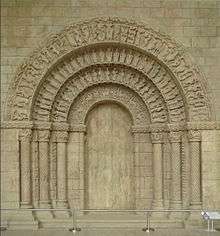 Portal of Eglise Saint-Pierre, Aulnay-de-Saintonge, mid-12th century.
Portal of Eglise Saint-Pierre, Aulnay-de-Saintonge, mid-12th century. Islamic stylistic influence in the Church of Saint-Pierre.
Islamic stylistic influence in the Church of Saint-Pierre.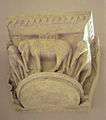 Capital with elephants on the Church
Capital with elephants on the Church A Church window
A Church window The south side of the Church
The south side of the Church Detail of the south side
Detail of the south side The Bell Tower
The Bell Tower The Stoup
The Stoup The Nave of the Church
The Nave of the Church- The cemetery next to the Church
- The Church of Notre-Dame (12th century)

- A Baptismal font (12th century)

- A Baptismal font (12th century)
- The Church of Notre-Dame
- Church of Notre-Dame entrance
- Capitals in the Church of Notre-Dame
- Stained glass in the Church of Notre-Dame
Facilities
Education
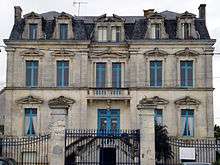
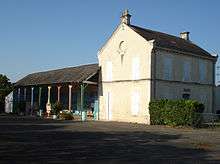
The town has a school grouping which brings together a kindergarten and a primary school located at Rue du 19 Mars 1962 in the town. This school includes all the classes that were previously separated between the girls' school and the boys' school. Although these schools maintained separation of the sexes until the 1960s, the two schools kept their names, despite the mix, until the construction of the new school in the 1990s. The former girls' school which had kindergarten and four classes to CE2 is now a hotel while the old boys' school which had three classes from CE2 to CM2 became the leisure centre for the town.
The Secondary College is a recently created public institution and is located near the site of the famous church of Aulnay. In September 2010 it had 252 pupils taught by a faculty of 22 teachers.
 College sign
College sign The College
The College
Health Services

Aulnay has a number of services in the medical, paramedical, and medical and social sectors which make it, as the capital of the canton, relatively well equipped in this area for Charente-Maritime.[21]
- Medical services
The town has three medical practices for General Practice in the centre of town. There are also two dental practices.
Aulnay does not have medical specialists and people usually visit those at Saint-Jean-d'Angely.
Aulnay does not have a medical radiology or MRI centre. The commune and the entire canton depend on Saint Jean d'Angely for this type of service.[Note 2]
Although the closest hospital is at Saint Jean d'Angely for the most mundane interventions, Aulnay and its canton actually depend on the Centre Hospitalier de Saintonge located in Saintes, some forty kilometres south-west. This hospital offers a very wide range of treatments as it is the largest hospital in the whole central part of the department of Charente-Maritime.
- Paramedical services

In this area, Aulnay has a slightly wider range of services. As the chief town of the canton it has a nursing centre in the town and a consulting room elsewhere in the commune. There are two physiotherapy practices and a speech therapist office.
In addition, there are two pharmacies and an optician. The commune does not have a medical laboratory with the nearest being at Saint-Jean-d'Angely.
Two ambulance services are based in Aulnay and cover the whole canton of Aulnay.
Aulnay is also equipped with a rescue centre where firefighters are available to intervene in emergency situations. This centre, under the SDIS Charente-Maritime, depends more directly on the main rescue centre in Saint-Jean d'Angely.
A veterinary clinic is active and serves all of the canton of Aulnay.
- Medical and social services
Aulnay has a public retirement facility where there are 43 furnished rooms in sheltered housing located in the town.[22]
Sports
Football is the main sport of the commune with a regional club which in 1976 was the winner of the Challenge Central-West.[23] The junior team also had its moment of glory reaching the qualifying pool for the 16th round of the Coupe Gambardella during the 1991–1992 season (which also included FC Nantes, Chamois Niortais, and Berrichonne de Chateauroux)
Other sports are represented such as archery with the Dungeon Archers Club and handball.
Notable people linked to the commune
- Robert Broussard, Chief of Police, comes from Aulnay.
See also
External links
- Aulnay on the Community of communes website
- art-roman.net Photos of Aulnay
- romanes.com Photos of Aulnay
- Aulnay on Google Maps
- Aulnay on Géoportail, National Geographic Institute (IGN) website (in French)
- Aunay on the 1750 Cassini Map
- Aulnay on the INSEE website (in French)
- INSEE (in French)
Notes and references
Notes
- At the beginning of the 21st century, the methods of identification have been modified by Law No. 2002-276 of 27 February 2002 , the so-called "law of local democracy" and in particular Title V "census operations" allows, after a transitional period running from 2004 to 2008, the annual publication of the legal population of the different French administrative districts. For communes with a population greater than 10,000 inhabitants, a sample survey is conducted annually, the entire territory of these communes is taken into account at the end of the period of five years. The first "legal population" after 1999 under this new law came into force on 1 January 2009 and was based on the census of 2006.
- Eleven towns in Charente-Maritime with a medical radiology centre are: Jonzac, Marennes, Rochefort, La Rochelle, Royan, Saintes, Saint-Jean-d'Angély, Saint-Martin-de-Ré, Saint-Pierre-d'Oléron, Saujon, and Surgères
References
- "Populations légales 2017". INSEE. Retrieved 6 January 2020.
- Inhabitants of Charente-Maritime (in French)
- Google Maps
- E. Lefèvre-Pontalis, Memoir in Archaeological Congress of France at Angoulême in 1912, Vol. I, 1913, Delesques, Caen. (in French)
- Ministry of Culture, Mérimée PA00104602 Chateau Tower (in French)
- Gaso.fr Archived 2010-03-06 at the Wayback Machine
- List of Mayors of France (in French)
- Eurotechnics Agri website (in French)
- Ministry of Culture, Mérimée IA17000315 Minargent Distillery (in French)

- Ministry of Culture, Mérimée PA00104602 Chateau (in French)

- Ministry of Culture, Mérimée IA17000314 Dairy Factory (in French)

- Ministry of Culture, Mérimée PA00104603 Cemetery Cross (in French)

- Ministry of Culture, Mérimée PA00104605 Church of Saint-Pierre d'Aulnay (in French)

- "Sculpted in relief, the first arch on the portal of Aulnay-de-Saintonge is covered with griffons and centaurs of Eastern inspiration". in Cité de L'Architecture et du Patrimoine, Guide du Musée p.48, ISBN 978-2-915755-20-6 (in French)
- "The representations of elephants on a capital of the church of Aulnay takes its model from the décor of ivory, fabrics, and silks of the Orient" in Cité de L'Architecture et du Patrimoine, Guide du Musée p.48, ISBN 978-2-915755-20-6 (in French)
- Ministry of Culture, Palissy PM17000031 Painting: Christ with doctors (in French)

- Ministry of Culture, Palissy PM17000030 Statue: Saint Peter as Pope (in French)
- Ministry of Culture, Palissy PM17000029 Stoup (in French)
- Ministry of Culture, Mérimée PA00104604 Church of Notre-Dame (in French)

- Ministry of Culture, Palissy PM17000032 Baptismal font (in French)
- Health directory website (in French)
- Summary presentation of the MDR L'Ouche-des-Carmes website (in French)
- Footbal, Challenge Centre-Ouest (in French)
| Wikimedia Commons has media related to Aulnay, Charente-Maritime. |
